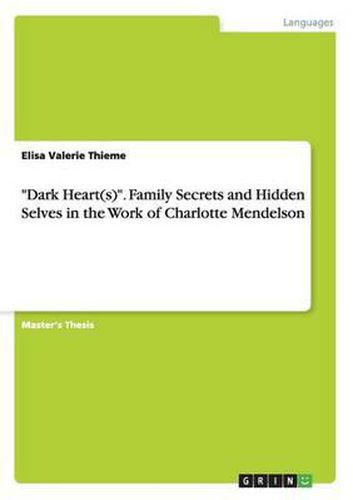Readings Newsletter
Become a Readings Member to make your shopping experience even easier.
Sign in or sign up for free!
You’re not far away from qualifying for FREE standard shipping within Australia
You’ve qualified for FREE standard shipping within Australia
The cart is loading…






Master’s Thesis from the year 2015 in the subject English - Literature, Works, grade: 1,7, Johannes Gutenberg University Mainz (DEL), course: British Studies, language: English, abstract: An analysis of genesis of Mendelson’s writing with particular focus on her British-Jewish background. So far, the British-Jewish novelist Charlotte Mendelson has published four books, namely Love in Idleness (2001), Daughters of Jerusalem (2003), When We Were Bad (2007), and Almost English (2013), which could all be typified as intercultural coming-of-age novels. The main source of inspiration appears to be Mendelson’s own multi-ethnic background. - She was born in London in 1972 and grew up in St John’s College, Oxford, where her father taught public international law. But even though she is English-born and has a Cockney grandfather, Mendelson identifies herself as not in the least English since her paternal grandmother stemmed from ‘Latvia and Poland’ (qtd. in Westbrook) and her maternal grandparents were ‘Hungarian-speaking-Czech, Ruthenian for about 10 minutes [and also somewhat] Carpathian mountainy’ (qtd. in Edemariam) and came to England with the last train out of Prague (Mendelson) fleeing from the Nazis as Jewish refugees (cf. Mendelson). Especially her maternal grandparents are a lasting inspiration for Mendelson. Her ‘Hungarian side is the side [she] like[s] showing off the most’ (qtd. in Westbrook) and is repeatedly referred to in interviews. Her hybrid background has enabled [Mendelson] to become an essentially diasporic writer (Cheyette, Diaspora and Multiculturalism 54) When reading Mendelson’s novels in chronological order, it seems as if her writing has undergone some development. Recurring topics and tropes, such as living in a supposedly cryptic family microcosm and the difficulties of finding one’s identity in circumstances that resemble exile, are condensed, deepened, and shaped into more complex versions. Hence, her work seems to
$9.00 standard shipping within Australia
FREE standard shipping within Australia for orders over $100.00
Express & International shipping calculated at checkout
Stock availability can be subject to change without notice. We recommend calling the shop or contacting our online team to check availability of low stock items. Please see our Shopping Online page for more details.
Master’s Thesis from the year 2015 in the subject English - Literature, Works, grade: 1,7, Johannes Gutenberg University Mainz (DEL), course: British Studies, language: English, abstract: An analysis of genesis of Mendelson’s writing with particular focus on her British-Jewish background. So far, the British-Jewish novelist Charlotte Mendelson has published four books, namely Love in Idleness (2001), Daughters of Jerusalem (2003), When We Were Bad (2007), and Almost English (2013), which could all be typified as intercultural coming-of-age novels. The main source of inspiration appears to be Mendelson’s own multi-ethnic background. - She was born in London in 1972 and grew up in St John’s College, Oxford, where her father taught public international law. But even though she is English-born and has a Cockney grandfather, Mendelson identifies herself as not in the least English since her paternal grandmother stemmed from ‘Latvia and Poland’ (qtd. in Westbrook) and her maternal grandparents were ‘Hungarian-speaking-Czech, Ruthenian for about 10 minutes [and also somewhat] Carpathian mountainy’ (qtd. in Edemariam) and came to England with the last train out of Prague (Mendelson) fleeing from the Nazis as Jewish refugees (cf. Mendelson). Especially her maternal grandparents are a lasting inspiration for Mendelson. Her ‘Hungarian side is the side [she] like[s] showing off the most’ (qtd. in Westbrook) and is repeatedly referred to in interviews. Her hybrid background has enabled [Mendelson] to become an essentially diasporic writer (Cheyette, Diaspora and Multiculturalism 54) When reading Mendelson’s novels in chronological order, it seems as if her writing has undergone some development. Recurring topics and tropes, such as living in a supposedly cryptic family microcosm and the difficulties of finding one’s identity in circumstances that resemble exile, are condensed, deepened, and shaped into more complex versions. Hence, her work seems to